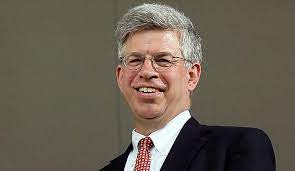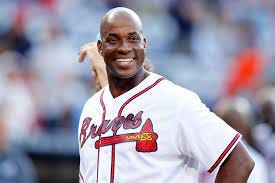On Saturday, thirteen pitchers exceeded six innings and gave up three or fewer earned runs. Their exploits were duly recorded as “quality starts.”
The man who brought that statistic to baseball was given a place in the Baseball Hall of Fame on Saturday, just down the hall from the gallery of plaques that honor the players.
John Lowe, proud beat writer for newspapers in Los Angeles, Philadelphia and Detroit, won the Career Excellence Award (formerly the Spink Award) as voted by the members of the Baseball Writers Association of America.
John was looking for a way to honor the work of starting pitchers, whose worth has been devalued over the years by bullpen-happy managers and statistical analysts. Originally, the “quality start” was derided as insufficiently demanding of starters. Would Bob Gibson consider six innings a quality workday? He was just getting lathered up. Besides, a minimum quality start would be the equivalent of a 4.50 ERA.
It almost seemed like John should have invented the NQS — the non-quality start, to denote which starters did not keep their teams in the game.
Now, of course, the starter is not expected to face a lineup for the third time in a game (horrors), and his work is arbitrarily defined by the number of pitches he throws, regardless of the stress level. Most pitchers realize that not all pitches are created equal. One guy might throw 90 pitches in five innings and feel fine, without stress. Another might have had to deliver 28 in one inning, which drains the tank.
Of those 13 quality-starters on Saturday, the only ones whose teams lost their games were those who were facing another quality-starter. The pitchers who dominate the stat are the ones who protect their bullpens by putting up innings, and who preserve the opportunities for their sluggers to make their money with late-inning hits that mean something.
Last year, two teams had quality starts in over half their games. They were Houston, the world champs, and San Diego, which got to the NLCS. This year only Seattle is at 50 percent at the moment, and the Mariners are still theoretically in the wild-card scramble.
In 2021 the world champion Braves were fourth in QS percentage as a staff. The Dodgers, their victims in the NLCS, were second. Oakland was the leader and had a 86-76 season.
Only 17 pitchers so far this year have averaged six innings per start regardless of runs allowed. So, if anything, the definition of a QS should be liberalized.
But Lowe should be the one who decides that, since his curiosity about the game was only matched by his steadfastness in fighting through the underbrush of details and coming up with a valid conclusion. In doing so he followed the spirit of Jerome Holtzman, who defined the save rule. When Lee Smith was elected to the Hall of Fame he made sure everyone knew how much Holtzman meant to him, and how much money the save rule made for him, too.
And, again, people can quibble with aspects of the save rule. But when coupled with save opportunities and amplified by bullpen WHIP, it’s the best measure of a closer.
Lowe did far more than dabble with numbers. He stood out, for one thing. He invariably wore a sport coat and usually a tie to the ballpark, and sometimes a white hat. He looks remarkably like Al Franken, the former Senator and all-situations comic, and indeed Rene Gonzales of the Orioles would bellow, “There’s Al Franken,” when Lowe entered the room.
He did not drink or curse or spit tobacco juice or get visibly angry about anything. He was incapable of the backbiting that plagues the dugouts and the press boxes. He wasn’t one of the guys by any means, and maybe that’s why he was popular with players and managers. They recognized how hard he worked and how much he cared. I’ve never met anyone who was more fascinated with the game, or anyone who found a more perfect outlet for that fascination. In doing so, Lowe informed and entertained generations of fans, particularly in Detroit, where he worked for the Free Press. In his Saturday speech he talked about the worth of teachers, which in his case were usually baseball managers like Whitey Herzog and Jim Leyland, but Lowe taught actual classes, too, and his daily work was a tutorial in itself.
One day the Tigers were going to Toronto, and Lowe was going through customs at Pearson International Airport. The Canadian guard asked him, “Is this business or pleasure?” Lowe smiled as only as he could and declared, “Well, it’s business. But it’s a pleasure.”
He also characterized many things — an outfielder’s play at the wall, a pitcher’s escape from bases loaded, or a tasty sandwich — as “outstanding.” And he made sure “outstanding” was in his final sentence Saturday.
On Sunday, Fred McGriff and Scott Rolen go into Cooperstown as distinguished players, on a rare weekend of peaceful consensus. Some are skeptical of Rolen’s election, but he was a dominant player at a third base position that never has recognized appropriately.
McGriff had to wait for the Veterans Committee to elect him, since he never even reached 40 percent on the writers’ ballots in his 10 years of eligibility. He was seen as a “compiler,” a guy who collected numbers because of longevity, and at first base McGriff was a power hitter in a power era who, it was thought, didn’t bring enough impact or versatility to the table.
There are too many compilers in the Hall and not enough players who made a significant splash, who sold tickets or changed their franchises. But you don’t do what McGriff did because you merely knew when to show up. He slammed 493 home runs with 1,550 RBI and had a career OPS of .886. He also had 2,490 hits in his career.
McGriff also got knocked because he played for six teams, including Tampa Bay twice. He was an original Yankee and was dealt to Toronto for reliever Dale Murray in one of those panic-borne trades that George Steinbrenner made a specialty. He was, well, outstanding in Toronto, but then was shipped to San Diego by the wily Pat Gillick, who picked up Robby Alomar and Joe Carter in the deal, and they brought the stuff of two World Series titles with them.
Maybe that hurt McGriff in the balloting. He would make his own impact later. The Braves, trying to haul down a torrid San Francisco team in the old National League West, traded some flotsam and jetsam for McGriff in the middle of the 1993 season. McGriff had a 1.008 OPS the rest of that season, and the Braves ran down the Giants. They did lose to the Phillies in the NLCS but McGriff blasted a memorable home run in Veterans Stadium. “Crime Dog killed a family of four in the upper deck,” John Kruk said.
McGriff hit 30 or more home runs 10 times, including 30 when he was 38 years old with the Cubs, plus 101 RBIs. Consistency is the trait that baseball people prize the most, because it brings the ability to adjust, to cope with the day-to-day emotional bends, and to either stay healthy or play well when you’re not. McGriff played 150 or more games in 10 different seasons and led the league in 1996, a season which started late because of the residue of the 1994 work stoppage. He played 144 that year.
He had a star’s brilliance and a workingman’s approach, and his ascension into baseball’s constellation will get applause from most everyone with whom he played. That’s the worth of Hall Weekend. It’s not just the memories, it’s the definition.





Another wonderful piece that began with a quality start.
Terrific stuff!